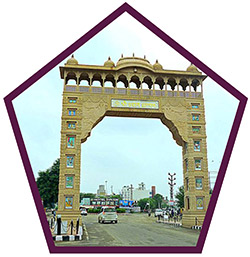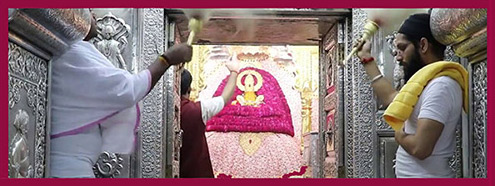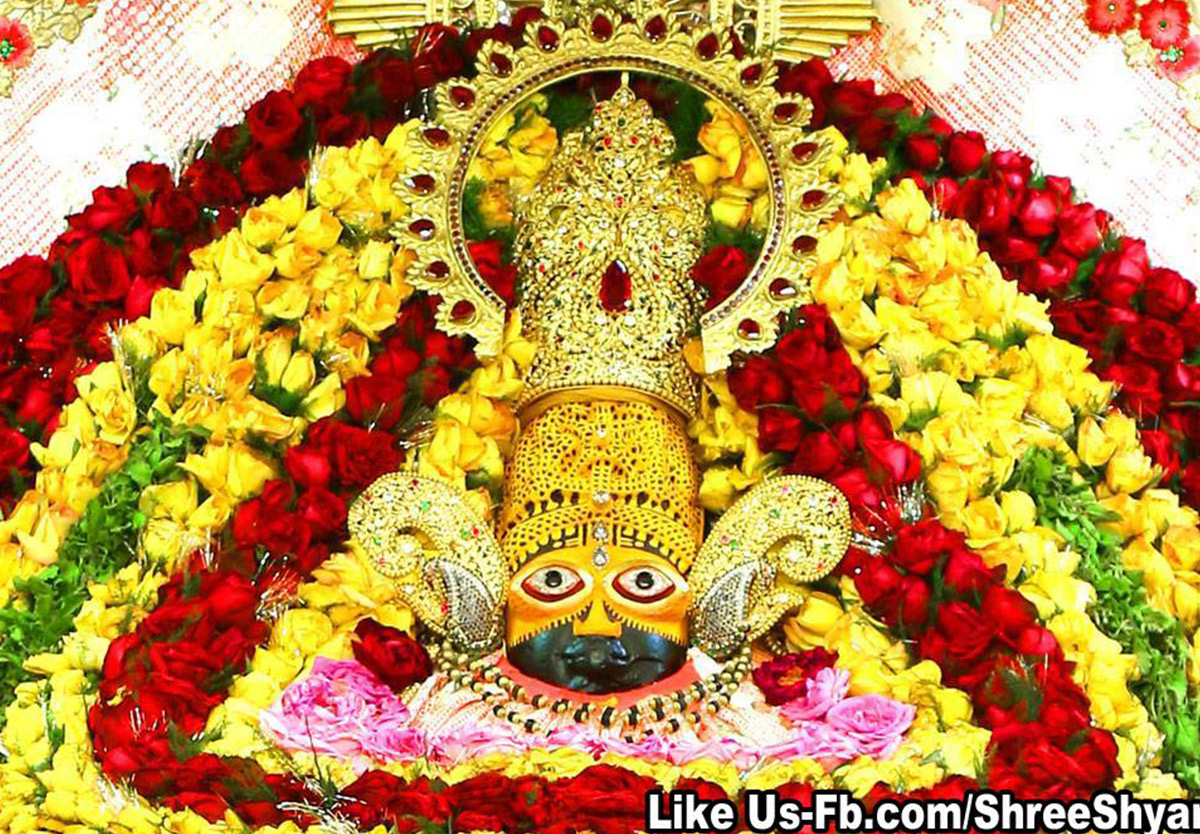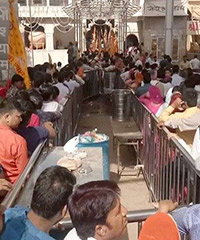
 Khaatu Shyamji is an important town in the Sikar district of Rajasthan. It is famous for the iconic and revered Khaatu Shyamji temple. Located in the Shekhawati region, this temple is very sacred because of the miraculous appearance of Lord Khaatu Shyamji making it a much-revered place for its devotees. This metaphysical presence of the Lord, is evident from the umpteen stories of faith and miracle in the hearts of its devotees.
Khaatu Shyamji is an important town in the Sikar district of Rajasthan. It is famous for the iconic and revered Khaatu Shyamji temple. Located in the Shekhawati region, this temple is very sacred because of the miraculous appearance of Lord Khaatu Shyamji making it a much-revered place for its devotees. This metaphysical presence of the Lord, is evident from the umpteen stories of faith and miracle in the hearts of its devotees.
Sikar, Shri Madhopur, Neem ka Thaana, are some of the major towns of Fatehpur Shekhawati district. Since Sikar district was established by “Veerbhan” it is also known as “Veerbhan ka Baas” (the abode of Veerbhan). Raja Madho Singh gave it the present name of Sikar.
Raja Madho Singh is also known for acquiring the coveted Ganesha idol, which is pivotal to Khaatu Shyam temple, by trick from the King of Kaasli. According to folklores, the famous Ganesha idol was gifted to the King of Kaasli by a saint. There were many blessings associated with this idol, one of them being that it made his kingdom unconquerable. Raja Madho Singh tried to conquer it many times but failed. Eventually he sent detectives to get more information about the idol. Eventually he plotted his trusted aide in the disguise of a Seer to help him get the coveted Ganesha idol. This time he succeeded and taking advantage of the situation, he attacked the kingdom the very next day and conquered it. To commemorate this victory, he got a Ganesha temple built in front of his palace which still stands tall at Subhash Chowk. Gopinath temple was also made by him.
Sikar is very famous for its Ram Leela shows. It was during his time that Ram Leela stage shows became a rage in Shekhawati and continue to be performed every year with much fanfare.
The story of Khaatu Shyamji temple goes back to the time of the ‘Mahabharata’ around 5500 years back. It revolves around great Barberic who was the grandson of Bheema and son of Ghatothkach. Barberic mastered the ‘Vedas’ and meditated to gain wisdom and power. He worshiped the ‘Nine Durgas’ at a secret place of Mahisagar Sangam. His dedication and austerity won him many supernatural bents along with some magical bows and arrows.

When the fierce battle of Mahabharata was to be fought in Kurukshetra between the Kauravas and Pandavas, Barberic took the blessings of his mother and proceeded to take part in the impending battle. Interestingly, instead of being in his grandfather’s party, he decided to be on the side of the losing party. When Lord Krishna got to know about it, he realized that this way there will never be a concrete conclusion to this battle and he didn’t want Barberic to be on the side of the ‘Kauravas’. He had to intervene and stop him from participating in the battle. Hence, he disguised himself as a Brahmin and met him on his way to Kurukshetra.
When asked, Barberic told him that he was going to participate in the battle but Lord Krishna asked him to prove his competence first. Barberic dazzled him with his archery skills as he was able to shed all the leaves of a tree with a single arrow barring the single one which was lying in Lord Krishna’s feet. Barberic requested the Lord to remove his feet from the leaf lest his foot could get wounded by the arrow. Shri Krishna removed his foot in lieu of a promise. Barberic agreed to fulfil whatever his Lord wished from him.
Lord Krishna asked for his head in return. Such was the greatness of Barberic that he agreed readily but demanded to see Lord Krishna in his divine form as he was sure that no mortal being would ever ask for such a sacrifice. It was then that Lord Krishna was obliged to descend in his true form and blessed him. He asked Barberic to offer his head to ‘Ranchandika’ and gave him the blessing that during Kalyuga, he would be worshipped in his name as a reward for his supreme sacrifice. He honored him that he will be revered in the name of Krishna till the earth, sun and the moon will exist in the universe. Since then, Barberic is worshipped in the name of Khaatu Shyamji and has become immortal. He enjoys the same divinity as Lord Krishna. His immortal head witnessed the entire battle of Mahabharata till the end and then later disappeared into oblivion.
Years later, when Kalyuga started, Lord Krishna descended miraculously on earth to bless his followers in the town of Khaatu Shyamji. It happened that a cow was continuously oozing milk on her way back to her home. When one of the shepherds saw this scenario, he narrated the incident to King Naresh of Khandela. He was mesmerized to hear the incident. Days later Lord Krishna came in his dream and instructed him to find his ‘Shaligram’ which was to be dug at the same place where the cow had oozed out milk. The ‘Shaligram’ was to be vested and whoever came to worship it, was blessed with Krishna’s divinity. Hence, the ‘Shaligram’ that was found from the earth was rooted and established with full fanfare at its current place in Khaatu Shyamji.
Narmadar Kanwar was among the Chauhan Rajputs who saved the deity from the destruction of terrorists by hiding it in his huts. During the time of Aurangzeb, the old temple was destructed but the place where Shri Shyam Deviji was kept secure is still there and is frequented by many devotees. The head of the priests still belongs to Narmada clan of Chauhan Rajputs.
Shri Shyam Mandir was established on “Jayesth Shukl 2 Samwat 1777” while the coronation was done on “Faalgun Shukl 7 Samwat 1777” as per the Hindu calendar
| Temple Opening | Morning 4:30 |
| Temple Closing | Afternoon 12:30 |
| Temple Opening | Evening 4:00 |
| Temple Closing | Night 10:00 |
| Temple Opening | Morning 5:30 |
| Temple Closing | Afternoon 01:00 |
| Temple Opening | Evening 5:00 |
| Temple Closing | Nigh 9:00 |
| Khaatu Shyamji’s Mangla morning Aarti: | Time : Morning 04.45 to 05.45 As the temple opens, Mangala aarti is the first aarti performed. |
| Khaatu Shyamji’s Shringar Aarti: | Time : Morning 07:00 to 08:00 Baba Shyam is adorned with flowers and jewellery while performing the Shringar Aarti. |
| Khaatu Shyamji’s Bhog Aarti: | Time : Afternoon 12:15 to 12:30 Baba Shyam is offered food and aarti is performed. |
| Khaatu Shyamji’s Sandhya Aarti: | Time : Evening 06:00 to 07:15 This aarti is performed during evening at the time of sunset. |
| Khaatu Shyamji’s Shayan Aarti: | Time : Night 09 :00 to 10:00 This aarti is performed during the evening at sunset after which the temple is closed for the day. |
| New Delhi |
|
Days |
|
| Flight | Departure | Arrival | |
| SG2248 | 20:00 | 20:55 | 1,2,3,4,5,6 |
| SG2637 | 11:10 | 12:30 | Daily |
| 9W756 | 21:15 | 22:20 | Daily |
| 9W855 | 22:40 | 00:05 | Daily |
| 6E-3813 | 19:35 | 20:45 | Daily |
| 6E-6606 | 06:00 | 06:55 | Daily |
| AI-0492 | 13:30 | 14:25 | Daily |
| 9I-0644 | 20:30 | 21:15 | Daily |
| Kolkata |
|
Days |
|
| Flight | Departure | Arrival | |
| I5-0587 | 22:45 | 00:45 | Daily |
| G8-702 | 18:55 | 21:15 | Daily |
| 6.00E-207 | 07:50 | 10:00 | Daily |
| 6.00E-237 | 21:25 | 23:50 | Daily |
| 6.00E-175 | 22:30 | 00:30 | Daily |
| Chennai |
|
Days |
|
| Flight | Departure | Arrival | |
| 6E-0442 | 20:05 | 22:50 | Daily |
| 6E-736 | 22:20 | 01:00 | Daily |
| Mumbai |
|
Days |
|
| Flight | Departure | Arrival | |
| AI-0612 | 13:55 | 15:35 | Daily |
| G8-388 | 08:10 | 09:50 | Daily |
| G8-492 | 15:55 | 17:35 | Daily |
| 6.00E-218 | 05:10 | 07:00 | Daily |
| 6E-965 | 09:10 | 11:15 | Daily |
| 6E-394 | 18:35 | 20:30 | Daily |
| 9W-7046 | 08:20 | 10:20 | Daily |
| 9W-7119 | 20:55 | 22:50 | Daily |
| SG-2683 | 05:45 | 08:50 | Daily |
| Ahmedabad |
|
Days |
|
| Flight | Departure | Arrival | |
| G8-701 | 08:50 | 10:15 | Daily |
| 6E-238 | 08:00 | 09:25 | Daily |
| Jaisalmer |
|
Days |
|
| Flight | Departure | Arrival | |
| SG-2981 | 10:25 | 11:50 | Daily |
| Udaipur |
|
Days |
|
| Flight | Departure | Arrival | |
| SG-2623 | 07:25 | 08:20 | Daily |
| SG-2982 | 18:40 | 19:50 | Daily |
| Varanasi |
|
Days |
|
| Flight | Departure | Arrival | |
| SG-2985 | 06:15 | 07:55 | Daily |
| Hyderabad |
|
Days |
|
| Flight | Departure | Arrival | |
| I5-1543 | 11:45 | 13:45 | Daily |
| G8-701 | 08:50 | 11:10 | 7 |
| 6E-6151 | 06:05 | 08:05 | Daily |
| SG-842 | 15:25 | 17:20 | Daily |
| Ahmedabad |
|
Days |
|
| Flight | Departure | Arrival | |
| G8-701 | 08:50 | 10:15 | Daily |
| 6.00E-238 | 08:00 | 09:25 | Daily |
| Varanasi |
|
Days |
|
| Flight | Departure | Arrival | |
| SG-2985 | 06:15 | 07:55 | Daily |
| Bangalore |
|
Days |
|
| Flight | Departure | Arrival | |
| I5-1721 | 09:15 | 11:50 | Daily |
| I5-1729 | 19:50 | 22:40 | Daily |
| 6.00E-169 | 04:00 | 06:30 | Daily |
| 6E-642 | 09:00 | 11:35 | Daily |
| 6E-556 | 20:15 | 22:45 | Daily |
| Dehradun |
|
Days |
|
| Flight | Departure | Arrival | |
| 9I-0691 | 05:55 | 09:30 | Daily |
| Guwahati |
|
Days |
|
| Flight | Departure | Arrival | |
| SG-841 | 06:55 | 09:25 | Daily |
| Hyderabad |
|
Days |
|
| Flight | Departure | Arrival | |
| I5-1543 | 11:45 | 13:45 | Daily |
| G8-701 | 08:50 | 11:10 | 7 |
| 6E-6151 | 06:05 | 08:05 | Daily |
| SG-842 | 15:25 | 17:20 | Daily |
| Pune |
|
Days |
|
| Flight | Departure | Arrival | |
| 9I-0691 | 05:55 | 07:30 | Daily |
| Surat |
|
Days |
|
| Flight | Departure | Arrival | |
| SG-2683 | 05:45 | 07:30 | Daily |
| Train No. | Days | From | To | Arr. | Dep. |
|---|---|---|---|---|---|
| 22452 | Wed, Sat | DEC | RGS | 13.50 | 10.00 |
| 12066 | Fri, Sat | NZM | RGS | 19.48 | 15.10 |
| 12981 | Daily | DEE | RGS | 23.15 | 19.40 |
The nearest railway station for reaching Khatu Shyam temple is Ringus Junction. Only passenger trains run from Jaipur to Ringus railway station. There are around 8 trains from Jaipur railway station which leave at 4:40 AM, 6:05 AM, 7:45 AM, 10:10 AM, 1:30 PM, 6:55 PM, 6:50 PM and 8:15 PM respectively for Khatu Shyam temple. Its takes around 1.5 hours to reach via train and most of the trains run on schedule
Trains for Jaipur
| Train No. | Days | From | To | Arr. | Dep. |
| 182 188 193 195 199 201 2181 2414 2467 2955 2966 2967 2969 2973 2975 2977 2979 2985 2988 2993 8473 9707 9772 9782 |
Daily Daily Daily Daily Daily Daily Daily Daily Daily Daily Daily 2,4 7 7,2 1,6 2 3,5,7 6 Daily 1,3,6 5 Daily 1,4 3,5 |
Hissar Hissar Kota Bayana Junction Sog Ajmer Jabalpur Jammutavi Bikaner Mumbai Central Udaipur City Chenni Central Coimbatore Indore Mysore Ernakulum Bandra Terminal Sealdah Gwalior Bandra Terminal Puri Bandra Terminal Amritsar Via Bhatinda Amritsar Via Jakhal |
Jaipur Jaipur Jaipur Jaipur Jaipur Jaipur Jaipur Jaipur Jaipur Jaipur Gwalior Jaipur Jaipur Jaipur Jaipur Jaipur Jaipur Jaipur Jaipur Jaipur Jaipur Jaipur Jaipur Jaipur |
9.15 23.00 4.00 20.15 22.20 21.55 12.30 9.45 11.40 12.55 6.00 5.55 5.55 8.25 5.55 14.05 10.40 23.30 22.20 6.40 5.55 18.45 8.10 8.10 |
- - - - - - - 10.10 - - 6.10 - - - - - - - - - 6.30 - - - |
Bypass Trains (Jaipur)
| Train No. | Days | From | To | Arr. | Dep. |
| 491 492 2015 2016 2307 2308 2315 2316 2395 2396 2461 2462 2463 2464 2465 2466 2915 2916 2957 2958 4059 4060 4311 4312 4321 4322 4853 4854 4863 4864 5269 5270 5631 5632 5715 5716 8631 8632 8474 9105 9106 9263 9264 9265 9266 9269 9270 POW POW |
Daily Daily Except 3 Except 3 Daily Daily 5 1 4 5 Daily Daily 3,5,7 2/3,4/5,6/7 Daily Daily Daily Daily Excl.2 Excl.3 Daily Daily 2,4,5,6 1,2,5,7 1,3,7 3,4,6 2,4,7 1,4,6 1,3,5,6 2,3,5,7 5 1 1,3 5,7 1,3,6 1,2,4 6 6 6 Daily Daily 3,7 1,4 6 7 6 2 4 6,7 |
Bhopal Jodhpur New Delhi Ajmer Howrah Jodhpur/ Bikaner Sealdah Udaipur City Rajender Nagar Bihar Ajmer Delhi Jodhpur Delhi Sarai Rohilla Jodhpur/ Bikaner Indore Jodhpur Ahamdabad Junction Delhi Ahmedabad JN New Delhi Delhi Jaisalmer/ Barmer Barelly New Bhuj Barelly New Bhuj Varanasi Via Faizabad Jodhpur Varanasi Via Sultanpur Jodhpur Muzaffarpur Ahamdabad Junction Bikaner/ Barmer Gawhati Kishanganj Ajmer Raanchi Ajmer Jodhpur Ahamdabad Junction Haridwar Porbandar Delhi Sarai Rohilla Okha Dehradun Porbandar Motihari Delhi Cant Jodhpur |
Jodhpur Bhopal Ajmer New Delhi Jodhpur/ Bikaner Howrah Udaipur City Sealdah Ajmer Rajender Nagar Jodhpur Delhi Jodhpur/ Bikaner Delhi Sarai Rohilla Jodhpur Indore Delhi Ahmedabad JN New Delhi Ahmedabad JN Jaisalmer/ Barmer Delhi New Bhuj Barelly New Bhuj Barelly Jodhpur Varanasi via Faizabad Jodhpur Varanasi via Sultanpur Ahamdabad Muzaffarpur Gawhati Bikaner/ Barmer Ajmer Kishanganj Ajmer Raanchi Puri Haridwar Ahamdabad Delhi Sarai Rohilla Porbandar Dehradun Okha Motihari Porbandar Gandahinagar COR |
9.45 17.10 10.45 17.35 0.00 1.40 18.30 8.35 13.25 2.10 2.25 0.40 13.55 23.50 17.20 10.47 4.20 20.25 2.25 0.40 23.45 4.50 17.40 7.55 11.30 15.30 11.30 15.30 11.30 15.30 20.55 4.00 8.20 23.30 19.15 13.45 21.10 22.45 19.10 22.45 4.30 13.45 13.55 4.00 19.15 13.45 19.55 3.15 23.35 |
11.55 17.35 10.50 17.45 0.15 2.00 18.50 8.50 13.35 2.25 2.35 0.50 14.15 0.05 17.40 10.55 4.35 20.45 2.30 0.45 23.57 5.00 18.00 8.15 11.50 15.50 11.50 15.50 11.50 15.50 21.15 4.10 8.40 23.40 19.35 14.05 3.25 21.35 19.40 23.05 4.55 14.05 14.15 4.10 19.35 14.05 19.35 19.30 0.45 |
| Name of the Hotel | No. of rooms available | Contact No. | Address |
|---|---|---|---|
| Kashi Dhaam Banaras waalon ke | 9828630355 | Near Petrol Pump | |
| Gurudhaam | 001576231372 | West of Petrol Pump | |
| Sri Shyam Maatr Chaaya Pilani | 09351382170 | Hanuman Pura Road | |
| Delhi ke Shyam Bishraam Bhawan | 07733439594 | On Laamiya Road | |
| Naarnaul Shri Shyam Sabak Bhakt Mandal | 0992927262 | East of Gokul Dhaam | |
| Sukhdhaam Charitable Trust | 09929623237 | Ringus Road | |
| Karnbaati Bhawan Sri Seva Trust Ahmedabad | 09929623237 | Ringus Road | |
| Sri Shyam Seva Samiti Aadigodd Brahmin Samaj Samiti | 08003121357 | Near Mattiya Bridge | |
| Sri Shyam Charan Seva Trust | 09929161437 | Ringus Road | |
| Sri Khatu Shyam Athithi Niwas Delhi | 09950977400 | Ringus Road |
‘Shyam Kund was the place from where the divine deity was found miraculously. It is believed that a holy dip in this pond relieves your past sins and brings peace upon you.
Shyam Bagh also holds a very important place in the hearts of devotees. This beautiful garden blooms with the love and blessings of the lord. It is also the place where the mausoleum of Aalu Singh, one of the devout devotees, is also situated. The flowers grown in this garden are used to adorn the deities of Shri Khaatu Shyam Baba.

Keeping in mind the sentiments of its devotees, we have made adequate safety measures to ensure the safety of the visitors during this pandemic. The temple of Khaatu Shyaamji opened in December 2020 and online registration is made mandatory for everyone. For the safety of one and all, the following protocols are followed:
Since its inception, the Chief Priest of the temple has been a Chauhan Rajput. All the movable and immovable assets of the temple are being looked after by them. The ‘Chauhans’ have served this temple since many generations for which they have also established a hereditary Trust in 1986 to look after its overall working which is known as ‘Shri Shyam Mandir Committee’. The President of this Trust is Shri. Shambhu Singh Chauhan while Shri Shyam Singh Chauhan is the minister and Shri Kaalu Singh is the treasurer.




.
.
‘Nishaan Yatra’ is an important aspect of this fair. It is a kind of walking expedition where the devotees walk all their way to Khaatu Shyamji with the sacred flag in their hands. This 14 kms trek usually starts from Ringus to Khaatu Shyamji temple although it depends upon the devotees, some of them also start this expedition from as far as Jaipur, Delhi or even Kolkata. The followers of Baba Shyamji have a staunch belief that if they complete the ‘Nishaan Yatra’ successfully, the Lord blesses them with their choicest blessings.
Upon the completion of the expedition, the “Nishaan” is bestowed upon Baba Shyam to commemorate his supreme sacrifice of giving up his life to Lord Krishna by beheading himself.
The so called “Nishaan” is a kind of flag in saffron, white or red colour. It also carries the picture of Shri Shyam and his verses while some also have coconuts and peacock feathers on it. It is tied to a rope so that it can swirl in the air. Now days, many devotees have even started the “Nishaan’ made in gold and silver.


As per the Hindu calendar, Ekadashi is celebrated on the 11 day of Hindu moon. It comes twice in a month one after Poornima and the other after Amavasya. The one which comes after Poornima is known as Krishna Paksh Ekadashi while the one which happens after Amavasya is known as Shukla Paksh Ekadashi. According to Sanatan dharma, these two are very sacred days in Hindu mythology. Ekadashi fasting has a lot of significance in the religion. Though we have 24 Ekadashis in a year, but during Adhikmaas and Malmaas, their number goes upto 26. Asaadh Maas Ekadashi which falls in June -July is known as Devshayani Ekadashi. This day is also celebrated as “Padmanabha’. It is believed that during this time, the sun enters the Gemini sign. It also marks the beginning of Chaturmaas. On this auspicious day, Lord Vishnu sleeps in the Sheersagar and he is woken up only after four months when the sun enters the Libra sign. This day is celebrated as Devothyaani Ekadashi.
The followers of Vaishnavism worship Lord Vishnu and idolize him in the form of Lord Krishna. Ekadashi is considered to be the most auspicious day for worshipping Lord Vishnu. Lord Khaatu Shyam is worshiped because of the blessings of Lord Krishna, hence Ekadashi is also considered to be an auspicious day for him.
Similarly, the 12th day of Hindu calendar is known as Dwadashi which also comes twice in a month, one after Poornima and the other after Amavasya. Similarly, the first one is known as Krishna Paksh Dwadashi and the other one is known as Shukla Paksh Dwadashi. According to Hindu mythology, Dwadashi is considered very auspicious for worshiping Lord Krishna. Legend has it that fasting on this day gets you the Lord’s choicest blessings. Since Lord Krishna is a reincarnation of Lord Vishnu, fasting on Dwadashi is very beneficial for devotees. Importance of Dwadashi for Shyam Baba
It is believed that Sri Shyam Baba had made the supreme sacrifice of giving up his life on Faalgun Shukla Paksha Ekadashi and became a witness to the battle of Mahabharata. Therefore, on this day, Baba Shyamji’s jyot is felicitated with kheer and churma prasad.
Every year, a grand fair is organised on Falgun Ekadashi which falls in the month of February and March. One of the major festivals of Lord Shyam, this fair is celebrated for 5 days stretching from Ashtami to Dwadashi. Looking at the increasing number of devotees visiting it, the duration of this fair has now been extended to 9 -10 days. Devotees flock to this fair from all across the country along with their friends and relatives to visit Khaatu Baba during this time. Musicians from different parts of the country also come here to perform. The stay in the local guest houses and sing hymns of Shyam Baba.
Nishaan Yatra’ is an important aspect of this fair. It is a kind of walking expedition where the devotees walk all their way to Khaatu Shyamji with the sacred flag in their hands. This 14 kms trek usually starts from Ringus to Khaatu Shyamji temple although it depends upon the devotees, some of them also start this expedition from as far as Jaipur, Delhi or even Kolkata. The followers of Baba Shyamji have a staunch belief that if they complete the ‘Nishaan Yatra’ successfully, the Lord blesses them with their choicest blessings.
Upon the completion of the expedition, the “Nishaan” is bestowed upon Baba Shyam to commemorate his supreme sacrifice of giving up his life to Lord Krishna by beheading himself.
The so called “Nishaan” is a kind of flag in saffron, white or red colour. It also carries the picture of Shri Shyam and his verses while some also have coconuts and peacock feathers on it. It is tied to a rope so that it can swirl in the air. Now days, many devotees have even started getting the “Nishaan’ made in gold and silver.
The Rath yatra starts on the day of Falgun Ekadashi at around 11 am with much fanfare. The idol of Shri Shyam riding a blue horse in kept in the Rath for the devotees. The holy saints belonging to Chauhan Rajputs perform the aarti and take their coveted seat along with the holy idol. They perform rituals of washing the feet of the idol and distribute prasad to the devotees and bless them with the help of Shri Shyam’s holy stick bedecked with peacock feathers.
Shobha Yatra is a sight to behold for the devotees of Lord Shyam who flock to the place to catch a glimpse of their beloved God. This yatra starts from the temple and reaches till Shyam Kund. The holy water is used to commemorate the idol right at the place where it was found. Henceforth, the Rath Yatra proceeds to Ganesh Dasji mandir from where it moves towards Rewari dharamshala and then towards the hospital to Panchayati Dharamshala to finally reach the market. Till the commencement of the fair, the Rath is kept in the main bazaar for the devotees. The devotees believe that Shyam Baba himself comes out of his temple once every year during this time to see and bless his devotees and the devotees are expected to stand on their terraces and welcome their lord.
On the day of Dwadashi, the yatra resumes again with Lord Khaatu Shyam beseated on the rath. The Shobha Yatra is flocked by 15 to 20 thousand devotees and is an awesome sight to see for the visitors. This holy sight is very special for the people.
Khaatu Baba’s head is kept in the Khaatu Shyamji mandir on the day of Kartik Shukla Ekadashi, hence Shyam Baba’s birthday is also celebrated on this day.
